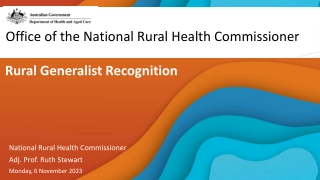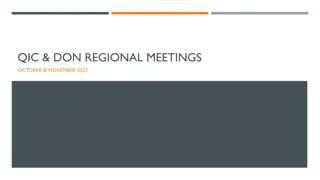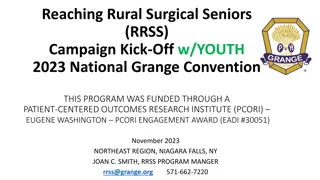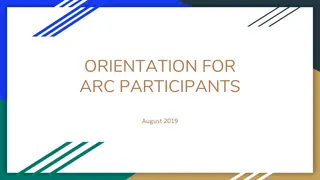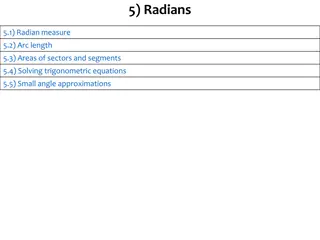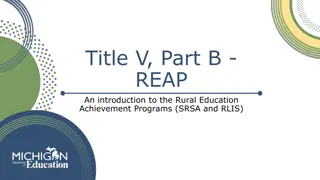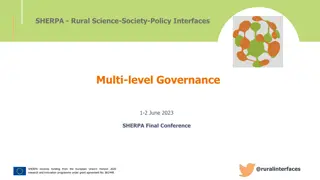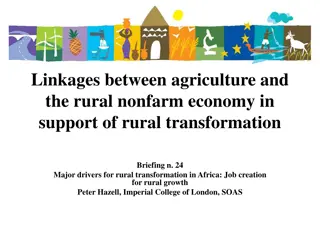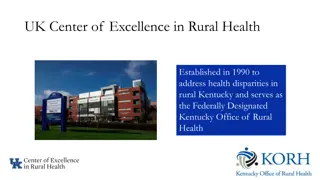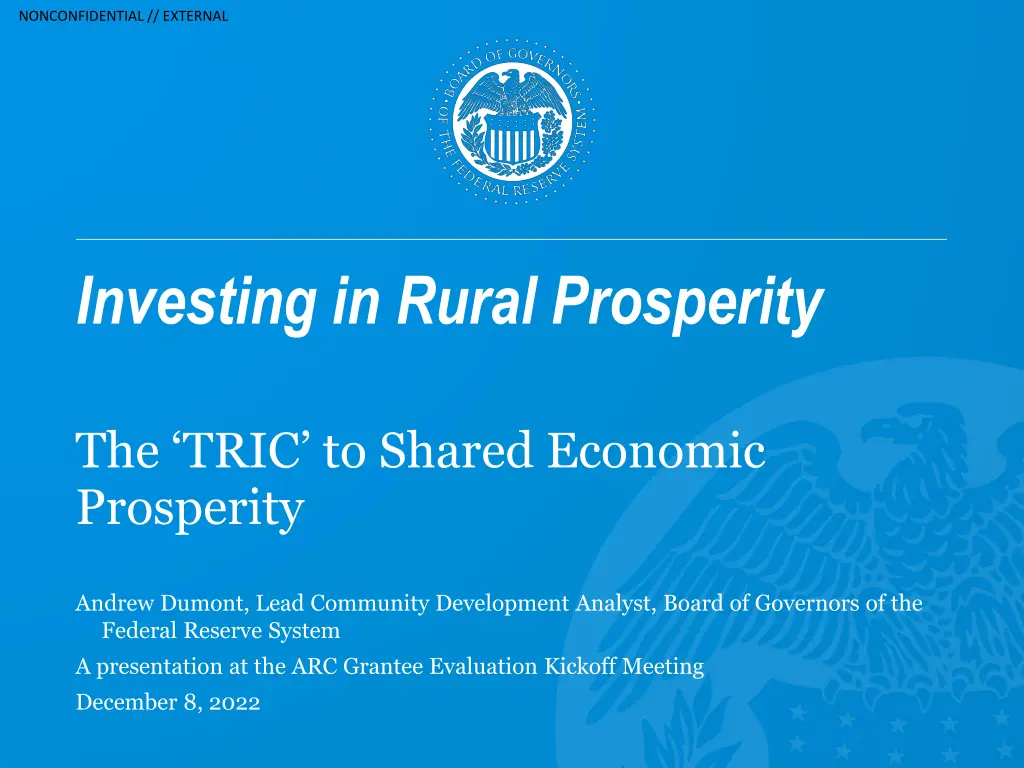
Investing in Rural Prosperity: A Framework for Economic Growth
Discover how investing in rural prosperity can lead to shared economic growth and opportunities. Explore the TRIC framework for fostering prosperity in historically marginalized rural communities. Access valuable insights, case studies, and policy considerations to support rural development stakeholders. Learn more at www.stlouisfed.org/investinrural.
Download Presentation

Please find below an Image/Link to download the presentation.
The content on the website is provided AS IS for your information and personal use only. It may not be sold, licensed, or shared on other websites without obtaining consent from the author. If you encounter any issues during the download, it is possible that the publisher has removed the file from their server.
You are allowed to download the files provided on this website for personal or commercial use, subject to the condition that they are used lawfully. All files are the property of their respective owners.
The content on the website is provided AS IS for your information and personal use only. It may not be sold, licensed, or shared on other websites without obtaining consent from the author.
E N D
Presentation Transcript
NONCONFIDENTIAL // EXTERNAL Investing in Rural Prosperity The TRIC to Shared Economic Prosperity Andrew Dumont, Lead Community Development Analyst, Board of Governors of the Federal Reserve System A presentation at the ARC Grantee Evaluation Kickoff Meeting December 8, 2022
NONCONFIDENTIAL // EXTERNAL Table of Contents SECTION 1 2 3 Investing in Rural Prosperity: An overview SECTION TRIC: A Framework for Fostering Shared Economic Prosperity SECTION Supporting Small Business and Entrepreneurship using TRIC Principles Board of Governors of the Federal Reserve System 2
NONCONFIDENTIAL // EXTERNAL Disclaimer The information, analyses, and conclusions set forth are those of the presenter and do not necessarily indicate concurrence by the Board of Governors of the Federal Reserve System, the Federal Reserve Banks, or members of their staffs. Board of Governors of the Federal Reserve System 3
NONCONFIDENTIAL // EXTERNAL An Overview of Investing in Rural Prosperity Board of Governors of the Federal Reserve System 4
NONCONFIDENTIAL // EXTERNAL INVESTING IN RURAL PROSPERITY Investing in Rural Prosperity: An overview What is Investing in Rural Prosperity? An edited book, published by the Federal Reserve Bank of St. Louis and the Federal Reserve Board, which is available free of charge to the public electronically and in hard copy Why did we publish this book? To help inform rural development stakeholders how policies, practices, and funding streams at the local, state, and federal level can support the achievement of shared economic prosperity in rural communities, especially historically marginalized areas. What does the book contain? A high-level overview of the past, present, and potential future of economic opportunity in historically marginalized rural places, including key factors driving those outcomes A framework for fostering shared economic prosperity in rural communities Case studies showing how rural communities across the country have made strides in creating opportunities for their residents Key policy, practice, and funding considerations Where can I access the book? www.stlouisfed.org/investinrural Board of Governors of the Federal Reserve System 5
NONCONFIDENTIAL // EXTERNAL A Framework for Fostering Shared Economic Prosperity Board of Governors of the Federal Reserve System 6
NONCONFIDENTIAL // EXTERNAL THE TRIC FRAMEWORK The TRIC to shared rural prosperity Rural communities are more likely to achieve broad-based economic prosperity if they take an asset-based, equitable approach to development To that end, in this book we propose an approach to rural development that is: Tailored to the specific goals, assets and organizational infrastructure of the community; Designed to be resilient to changing circumstances; Intentionally inclusive about who is at the decision-making table and who benefits from local development; and Created and carried out through a collaborative process. We think this approach is the TRIC to fostering shared economic prosperity in rural communities Board of Governors of the Federal Reserve System 7
NONCONFIDENTIAL // EXTERNAL THE TRIC FRAMEWORK Tailored: Ensuring the Strategy Fits the Place Attempts to support shared economic prosperity in rural places will be most effective when they are tailored to the specific community in which they are being carried out. This means the strategy is fashioned around: The goals of the community The specific assets present in the community The community s organizational capacity Every community has a different history and so has evolved with a unique set of institutions. As a result, the organizations that develop and implement a rural development strategy will likely be different in each community. Rural development plans that are simply replicated from somewhere else have little chance of being successful, as they are unlikely to closely match the skills, abilities, and interests of community members. Board of Governors of the Federal Reserve System 8
NONCONFIDENTIAL // EXTERNAL THE TRIC FRAMEWORK Resilient: Designing for Durable Adaptability To have long-term, positive effects on the community, rural development efforts must be structured in a way that is resilient to both the sudden shocks and gradual changes that will undoubtedly occur over time. The changes that may affect a community include but are not limited to: Climate-induced natural disasters Financial market disruptions Widespread or localized economic restructuring Pandemics Communities should build resiliency into how they plan and structure their development activities. For example, rural development efforts should not be overly reliant on one person, organization or industry. Rural development strategies should be future-oriented, updated on an ongoing basis, and consistently evaluated to assess their performance. Board of Governors of the Federal Reserve System 9
NONCONFIDENTIAL // EXTERNAL THE TRIC FRAMEWORK Inclusive: Engaging and Benefiting the Full Community To advance shared economic prosperity in a rural place, development activities must be inclusive of the full range of people living in the community, especially those who traditionally may be on the sidelines. Being inclusive means more than just inviting a couple more diverse people into the existing process; it means rethinking your entire approach. It often means by ensuring that traditionally marginalized groups have a seat at the table, not only to have their voices heard but to actually exercise decision- making power. It also requires prioritizing at all stages the distributional effects of choices on different groups, and how those choices relate to their desires, needs and skills. Those on the sidelines of the community are often there because obstacles exist that limit their participation. Intentionality is required, therefore, to address the barriers they face and to open the door for new opportunities. Ensuring everyone benefits from the community s growth and prosperity will strengthen the community s fabric and lead to a stronger economy. Board of Governors of the Federal Reserve System 10
NONCONFIDENTIAL // EXTERNAL THE TRIC FRAMEWORK Collaborative: Advancing Further Together Rural communities are more equipped to advance shared prosperity when people from throughout the community and across the region collaborate to formulate and implement development strategies. Communities that achieve success over time pursue cross-sector approaches, whereby leaders from the nonprofit, for-profit, financial, government and philanthropic sectors work together. Even if a rural community works well across sectors within its own borders, it may still struggle to marshal the resources needed to make the most of the opportunities available to it. This is when regional collaboration is necessary. The best collaborations seek to build consensus and employ a distributed leadership approach. Collaborations are more durable when all involved feel their voices are heard, respected and given appropriate weight. Identifying what everyone brings to the table, agreeing on common goals and pursuing a common vision will help make collaboration a reality. Board of Governors of the Federal Reserve System 11
NONCONFIDENTIAL // EXTERNAL Applying the TRIC Framework to Efforts to Support Small Businesses and Entrepreneurs Board of Governors of the Federal Reserve System 12
NONCONFIDENTIAL // EXTERNAL TRIC , SMALL BUSINESS, AND ENTREPRENEURSHIP Rural entrepreneurship: Keys to success Collaborate across the government, private, nonprofit and philanthropic sectors to identify needs and coordinate available resources Encourage local leaders to make a deep, long-term commitments to support entrepreneurs and small businesses Create a tailored strategy dedicated to capitalizing on unique local assets and opportunities Invest in local entrepreneurship support capacity and regional relationships Recognize diversity and inclusiveness as competitive advantages to be fostered and leveraged Board of Governors of the Federal Reserve System 13
NONCONFIDENTIAL // EXTERNAL TRIC , SMALL BUSINESS, AND ENTREPRENEURSHIP Promising Examples of Local Efforts from Investing in Rural Prosperity In Sacramento, California economic development leaders, industry and university partners, and policy officials are working together to create a cohesive regional ecosystem to support the life sciences and agricultural biotechnology industry clusters. In Eastern West Virginia, several partners came together to form the Ag Action Council, which identified significant potential for the region in developing industries reliant on biomass (biochar, biofuels, etc.). Since the region has a concentration of raw materials useful for biomass, this asset- based approach leverages the region s existing assets to create new opportunities. Higher Purpose Co. is an economic justice nonprofit in Mississippi that aims to build community wealth among Black Mississippians by advancing Black entrepreneurship and access to capital. HPC s work includes the Higher Purpose Funding Network, the Higher Purpose Business Fellowship, and the Higher Purpose Institute for Black Entrepreneurship. Board of Governors of the Federal Reserve System 14
NONCONFIDENTIAL // EXTERNAL TRIC , SMALL BUSINESS, AND ENTREPRENEURSHIP Promising Examples from IRP (continued) CEI of Maine operates the StartSmart program, which provides no-cost, confidential, and linguistically and culturally sensitive business advice to community members who are refugees and immigrants. They also offer Sharia-compliant financing options for their Muslim clients to ensure they have access to culturally appropriate financing. Wallowa Resources in Oregon has expanded opportunities in the forest sector beyond timber harvest to include forest and watershed restoration. Their work has included supporting the use of small-diameter logs by directly investing in businesses and small-scale, distributed renewable energy technologies. Great Lakes Community Action Partnership supports entrepreneurship in Ohio through their Entrepreneurial Communities Initiative, which is funded through USDA s Rural Community Development Initiative. GLCAP designed the program with certain core elements they believe are crucial to the success of the program, while being flexible enough to meet the needs of communities with differing capacities, assets and goals. Board of Governors of the Federal Reserve System 15
NONCONFIDENTIAL // EXTERNAL Thank you! Questions? Andrew Dumont Lead Community Development Analyst Federal Reserve Board Andrew.m.Dumont@frb.gov Board of Governors of the Federal Reserve System 16

